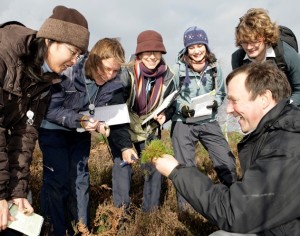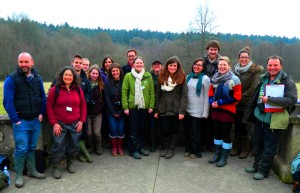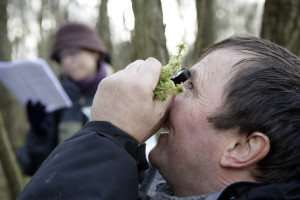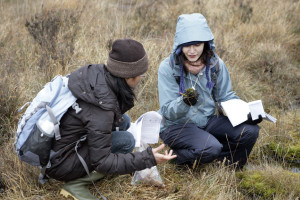Since its launch earlier this year, eXtreme botany has created more than a few ripples in the global botanical community. Here, exclusively and for the first time Dr M explains what eXtreme botany means to him and what it could mean to you…
What is extreme botany?
eXtreme botany is my concept of teaching botany that brings together a number of my keen interests:
- Showing people how exciting plants can be and giving people the tools they need to become extremely knowledgeable about plants.
- Showing people that to get to an expert level they will need to identify plants under extremely challenging conditions, but this is also where the real excitement is – mastering the botanical extremities.
- Using video as a medium for species identification and also giving other teachers the skills they need to teach plant identification.
Here are some examples
 eXtreme botany is about taking your plant ID skills to the next level
eXtreme botany is about taking your plant ID skills to the next level
There are around 1500 species of native plants in the UK and the same number again introduced and naturalised. You can learn to identify one but you can also learn to identify 1500 or even 3000. Can you imagine the feeling of knowing all the species of plants growing around you? The connection you feel when you are that familiar, that in touch with your surroundings. So, eXtreme botany is all about taking your plant ID skills to a higher level, and higher and higher still! How high can you go? The limit is set by you, so ultimately, it is you that is in control of your botanical destiny!
eXtreme botany is about gaining the necessary skills
eXtreme botany is about the skills needed to identify new and unfamiliar plants and difficult atypical specimens or plants in extreme environments, like winter when there are no flowers, or drought when they are all dried up, or grasses in a mown lawn all chopped up by the lawn mower.
eXtreme botany is about using keys.
Picture books are great for the early stages of plant ID and they retain value for checking determinations, but to really raise your skills and ID difficult and new species then there is no substitute for keys. This takes effort and dedication to learn about different types of keys, how they work and how they fail. To learn how to use keys and to understand the often difficult language and terms in the keys, and learning the short cuts that work and the ones that don’t! Learning to use keys is about failing well as succeeding! All essential for the extreme botanist!
eXtreme botany is about other identification aids
The proper use of the most important tool of the field botanists trade, the hands lens for checking important parts of plants in the field. A microscope is a more specialist piece of kit but is really valuable for checking details in the laboratory, it is amazing how different and beautiful plants and their intimate parts look under then microscope!
eXtreme botany is about having a good eye
You need to know what to look for and how to look for it. For example, checking the hairs on a grass leaf – roll the leaf around your forefinger keeping the upper surface uppermost, hold up in the light and, with the hand lens, look directly across the leaf surface, this will show exactly what the hairs are like, and, even if they are tiny, you will see them this way, but could miss them (or misunderstand them) if you just look at the leaf flat on.
A good eye is essential finding plants in the field too. It is surprising what you can miss if you don’t look properly! In grasslands for example, it helps to get down low in the vegetation and to look across (rather than down into) the vegetation to spot different plants at different levels in the vegetation. The good eye will help you detect different colours or shades of green which can indicate different species. You also need to know where to look for certain plants which might be located in wetter or drier or more open parts of the site. This is all important and takes experience and time to develop, but it’s worth it!
eXtreme botany is also about having a good ear!
What does this mean?! Well, I always tell my students that the best chance of correctly identifying a plant new to you, is to listen to the plant! What I mean here is, don’t jump to conclusions based an a cursory look. Here’s an example. Recently I was training some botanists and we looked at a small tree planted in the car park area. “It’s a Maple” they said with confidence, and indeed, the alternately arranged leaves DID look like the palmate leaves of a Maple (Acer spp.). “OK” I said, “But let’s just check more carefully”. There was Sycamore (Acer pseudoplatanus) growing nearby, so we went over to it to check for Maple characters (always a good plan to check against something you are sure of). “Describe the leaves of Sycamore” I asked them, “Green and palmate” they replied. “Yes, but how are they arranged” I quizzed them further, “Oh, in opposite pairs!” they exclaimed. “Yes” I said, “And your plant has alternate leaves so it CANNOT be a Maple!” It was in fact a Sweet Gum (Liquidamber styraciflua) not in the Maple family at all but in the Witch-Hazel family, and one of the “fake maples” which has fooled many a budding botanist! So, a quick decision can get you into trouble. Closed ears, like closed eyes, will lead to wrong conclusions!
eXtreme botany is about seeing plants afresh and not just as a backdrop
eXtreme botany is about the importance of plants and their value to humanity, but to me it is especially about the intrinsic fascination and beauty of plants. I believe that if we can get people interested in local plants they will make a personal connection to their local environment and their lives will be enriched, the more this happens the bigger the impact.
eXtreme botany is about your personal botanical journey
Your eXtreme botany journey depends on you. It depends where you start and where you want to go. So here are some examples to illustrate this point:
How do you start that journey?
For the botanical beginner, familiar perhaps only with a few common species, buttercups, dandelions, daisies and so on, the extreme botany journey can be about learning the identification features of the major plant families – the top-ten plant families is a very good and realistic place to start. The identification of different species in each family and more families can follow later once you have grasped the fundamentals of recognising the main families.
What if you already know plants?
For those starting out at a higher level, perhaps familiar with the common wildflower species and maybe some common grasses, for these people their extreme botany journey can develop this knowledge further, for example, to the identification of the different types of yellow composites (dandelion types) or different genera of grasses and different species such as different fescues, different meadow grasses and different bent grasses.
For the more advanced botanists, who already know a lot of plants, the extreme botany journey can travel into the identification of plants in extreme conditions, difficult atypical specimens or plants in extreme environments, winter plants with no flowers, or tiny plants in a closely grazed grassland.
Or your extreme botany journey can take your skills to the identification of new and unfamiliar plants or into more challenging groups like grasses, sedges or hawkweeds or dandelions or brambles or the identification of sub-species or hybrids, or into previously unexplored territories for you such as ferns or mosses or liverworts or lichens.
 Dr M uses video, why is this a useful medium for plant identification?
Dr M uses video, why is this a useful medium for plant identification?
I love the medium of video generally, but I also think it’s a great way to document species identification. I am an advocate of the 2-minute species ID video. Where in this short time period all the key features of a particular species or closely related group of species are covered leading to the correct identification at the end. There are about 3000 species of vascular plants in the UK, imagine the resource if every one of those plants had its own two minute video – books are great, keys are great, but video has the potential to show clearly all aspects of the the plant, in-situ, in the lab wherever.
 Finally, where can the eXtreme botanical excitement come from?
Finally, where can the eXtreme botanical excitement come from?
This is all about the thrill of the chase, seeing something for the first time, something growing wild. There is a buzz to be had from the discovery of something new that you have never seen before and there is a buzz to be had from seeing and knowing that your botanical skills are on the up and up. For example, when you no longer look the other way when you pass a sedge, or other potentially tricky plant, but instead but you actively engage with it, you embrace it, to see if it is one you already know or whether you need to exercise your botanical skills to work out what it might be!
There are lots of hooks into nature, recognising, knowing and identifying species can be a great feeling. You can set yourself personal targets, learn a species a day and this can be very addictive, in a good way! Very few people can walk out into their local environment, be it urban or rural, and name the species around them, and many people are impressed by those who can. Knowing the names of the trees in your street makes you notice and enjoy those trees more. Having this knowledge gives you a different, closer connection to your environment.
You will find once you start you will want to become an expert, you may specialise in one species group across the UK or Europe or World-wide, like grasses or orchids or conifers or mosses, you might want to concentrate on mastering all the plants in your local environment. It’s a skill that many people aspire to have but to achieve it takes a lot of dedication and hard work.
I never said eXtreme botany is easy! But what I do say, loud and clear, is that for sure it is well worth the effort!
and finally…
 I cannot end without mentioning the really huge buzz that I get from seeing my beloved students, and others, engaging with plants, realising that they actually rather like them, even love them, and really want to be able to identify them and to get better and better at it! For me this really is what makes the botanical World go round!
I cannot end without mentioning the really huge buzz that I get from seeing my beloved students, and others, engaging with plants, realising that they actually rather like them, even love them, and really want to be able to identify them and to get better and better at it! For me this really is what makes the botanical World go round!






